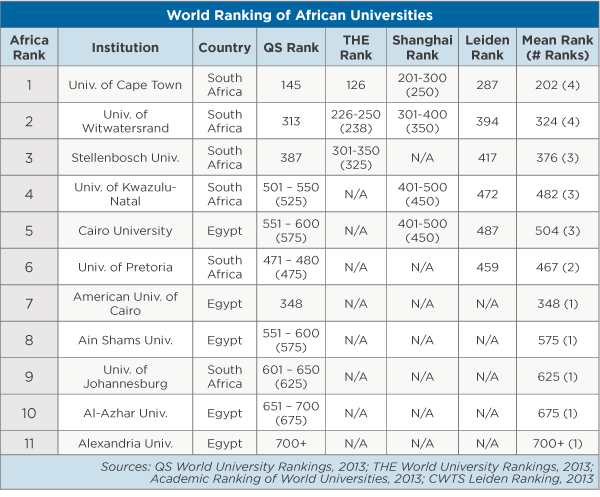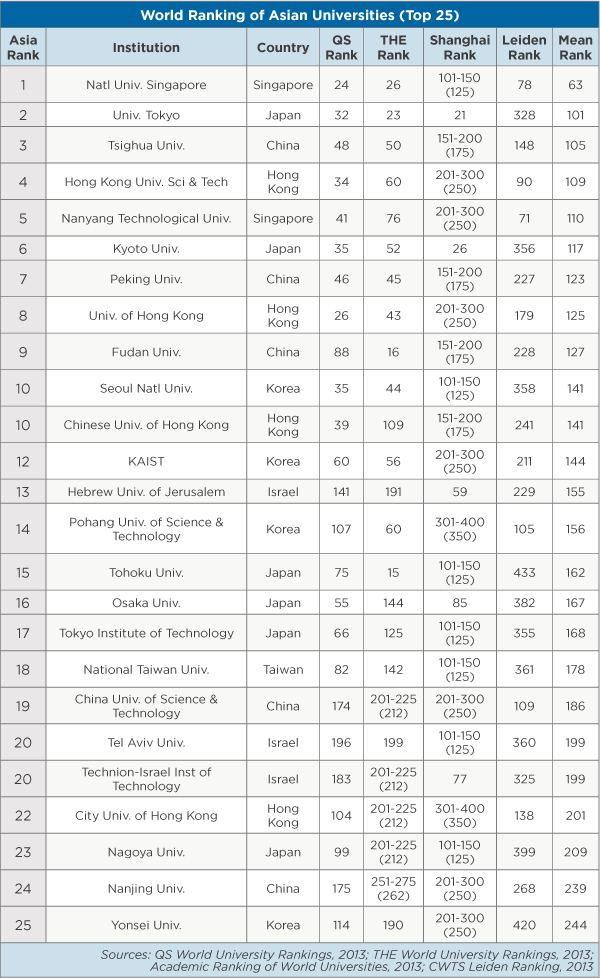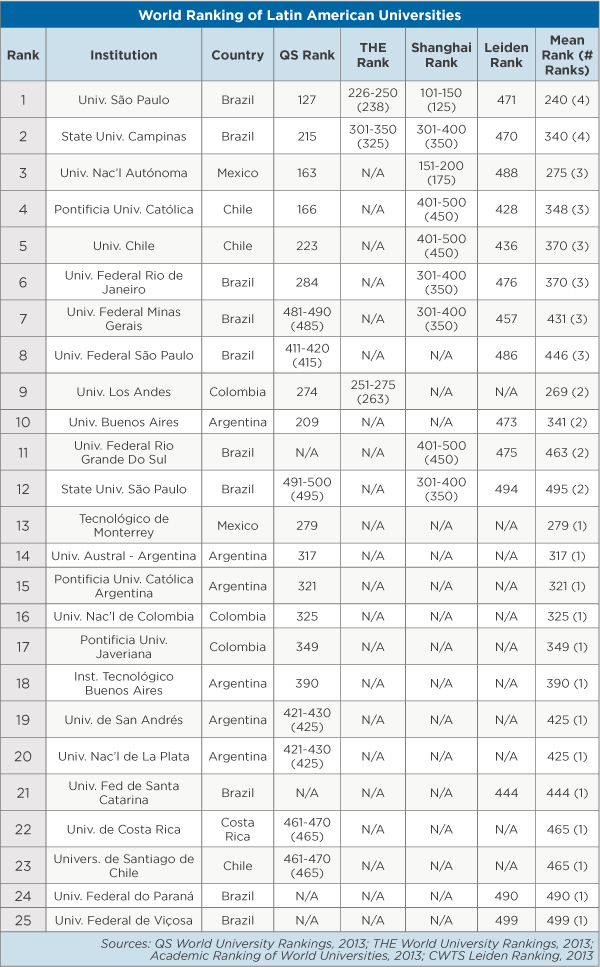The three most-watched world university rankings are released every year between August and October in what has become known as ‘rankings season.’ Invariably the headlines focus on U.S. and UK dominance, with a few paragraphs saved for universities from other regions that have performed well.
The story at the top is familiar to most who follow such things – Harvard, Stanford, MIT, CalTech, Cambridge, Oxford – but perhaps the more interesting and dynamic story is in the performance of universities from developing regions, many of which are working strategically towards improving their ranking positions and global reputations, oftentimes with targeted government funding.
For this edition of Under the Radar, we have produced a set of university rankings specific to Africa, Latin America, and Asia & the Middle East, based on institutional placements in four different rankings:
- CWTS Leiden Ranking [1] (Mean Normalized Citation Score) (April)
- Shanghai Jiao Tong Academic Ranking of World Universities [2] (August)
- QS World University Rankings [3] (September)
- THE World University Rankings [4] (October)
Each ranking has a different approach and methodology, but broadly speaking the Leiden and Shanghai rankings have a narrower focus on research excellence in technical fields based on highly quantitative proxies such as research citations and publication output, while the QS and THE rankings look to offer more broad-based assessments of university excellence by including measures such as class size, faculty numbers and campus diversity, in addition to opinion polls of faculty and researchers around the world that focus on their perceptions of other institutions’ research strengths.
Given the divergent foci of the different ranking systems, an aggregate of the four rankings offers a chance to rank institutions across a broader range of indicators. As can be seen in the results for all three regions, the Leiden and Shanghai results tend to skew lower for nearly all institutions across the regions sampled versus THE results and especially QS results. This may be because institutions in many of these regions have more of a teaching focus, and where research is being produced in significant volume it may not be getting published in the right journals or at the right conferences, as it is not being published in English and therefore may not be fully accounted for in the research-output indicators.
Africa

From the table above, it is quite apparent that African universities do not perform well in international rankings. In fact, just two countries have universities that appear in any of the four major rankings: South Africa and Egypt.
In addition, there is no single institution that appears in the top 100 of any of the rankings, while only two appear in all four rankings. By this measure, the universities of Cape Town and Witwatersrand are the best in Africa, with the University of Cape Town outscoring Witwatersrand by a handy margin in all four rankings.
Of the 11 institutions that feature in at least one ranking, six are from South Africa and five from Egypt. Indeed, no university from any other African country has ever appeared in the THE (formerly tabulated by QS) or Shanghai rankings since they started in 2004 and 2003 respectively.
With the focus that rankings place on research output as a proxy for quality, through publications, citations and polling, it is of no great surprise that African institutions perform poorly. African universities, broadly speaking, have to manage large student bodies – primarily at the undergraduate level – with limited financial and physical resources. Institutions are frequently short on academic staff, especially those qualified with PhDs, so not surprisingly their research output is poor.
Asia & the Middle East

Of the three ‘developing’ regions examined, Asia clearly has the largest number of top-ranking institutions with all 25 featured in the table above scoring in each of the four ranking systems. Unlike Africa, however, of the countries that are home to institutions featured in the ranking, most are today likely to be considered developed nations.
Among the top 25 institutions, five each are from Japan and China, four each are from Hong Kong and South Korea, three are from Israel, two are from Singapore, and one from Taiwan. All of these countries, with perhaps the exception of China, are today considered advanced economies. And while poverty is still a very real issue across much of China, all of its top-ranking schools are located in prosperous east coast provinces and receive supplemental government funding designed to boost international prestige and performance.
As in China, governments across Asia are investing strategically in higher education, especially at the elite level, while also focusing on internationalization activities such as the development of partnerships with top global universities, recruiting international students and faculty, and teaching and publishing in English. These are all areas of focus that are likely to boost global reputation and, therefore, placing in global rankings.
The top school on the list, the National University of Singapore, would be a prime example. Not only does it have a high-profile partnership [5] with Yale University – itself a perennial top-10 finisher on international rankings – but instruction and research is conducted in English, while double degree programs are offered in conjunction with a host of high quality international partner institutions. In addition, the university has a strong research focus with 23 research institutes and centers, while also having close affiliations with national-level research institutes and industry. Meanwhile, the government’s push to develop Singapore as a regional hub – or schoolhouse – for international students and research excellence has helped NUS recruit a talented student body that hails from over 100 different countries. These attributes tick many of the boxes that lead to international excellence, according to the proxies used by many of the ranking systems.
Latin America

There are enough institutions in Latin America scoring in at least one of the four international rankings to compile a top-25 list; however, like Africa, only two institutions feature in all four: University of São Paulo and State University of Campinas, both located in Brazil. Indeed, Brazil is home to 10 of the top 25 Latin American universities, according to our aggregates, followed by six from Argentina, three each from Chile and Colombia, two from Mexico, and one from Costa Rica.
Brazil holds an advantage over other countries in the region primarily because of its overall number of research-intensive universities and also because of a booming economy that has allowed significant recent investment in higher education, including the ambitious Science Without Borders program (now known as Scientific Mobility Program) that seeks to send 101,000 Brazilian STEM students overseas to top-ranked international universities by 2015. It also seeks to bring in foreign researchers to domestic institutions. Aside from dramatic increases in international academic mobility to and from Brazil, the program has also resulted in the inking of numerous collaborative agreements between prestigious international universities and Brazilian counterparts. The impact of the Scientific Mobility Program on institutional rankings among top Brazilian research institutions is likely to be a positive one moving forward.
Other countries, such as Chile and Mexico also have ambitious scholarship programs in place, or have recently announced similar plans. These initiatives could also pay rankings dividends in the not-too-distant future. The Mexican government announced in September that it planned to send 100,000 students to study in the United States by 2018, while also seeking to bring 50,000 American students to study in Mexico, according to a recent article in the Chronicle of Higher Education. Meanwhile, Chile has quietly been sending thousands of students overseas for graduate studies since 2008, with a goal of sending 30,000 students overseas by 2018, all in fields relevant to the national economy and labor market.
According to a 2012 article in University World News, “between 1995 and 2009 the number of Brazilian science papers multiplied by 3.6 times. The number of papers doubled in Mexico and Chile. It also multiplied by 3.8 times in Colombia, though from a low base. Since the mid-1990s Latin America has been the fastest growing region of world science, slightly ahead of Asia.”
However, Latin American universities are at a distinct disadvantage with regards to the citation indexes employed by all the ranking systems, as published research in Portuguese and Spanish are rarely cited outside the Ibero-American countries, and many non-English language journals are excluded from global databases.
